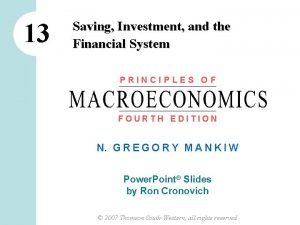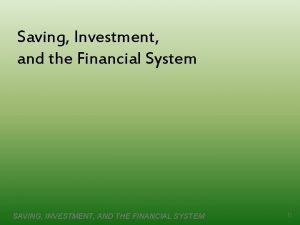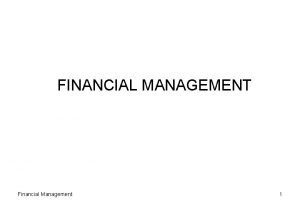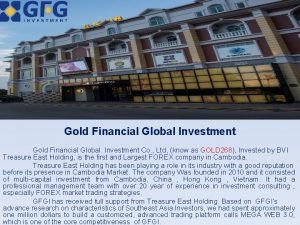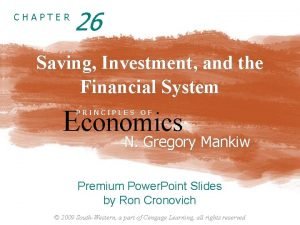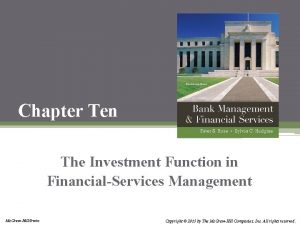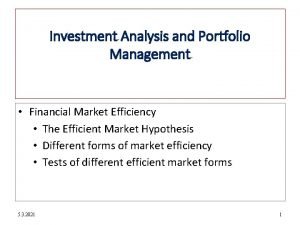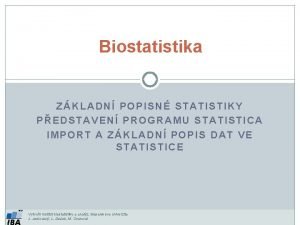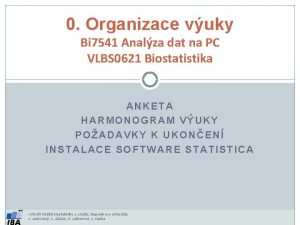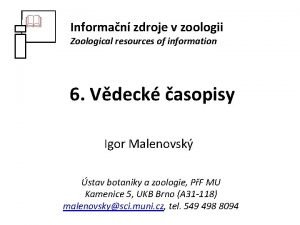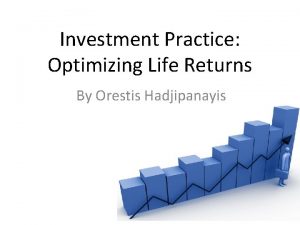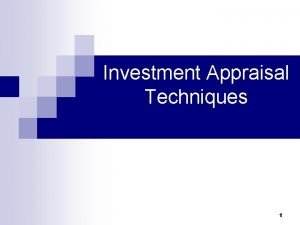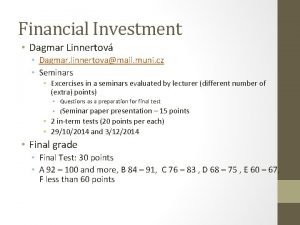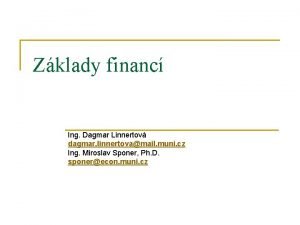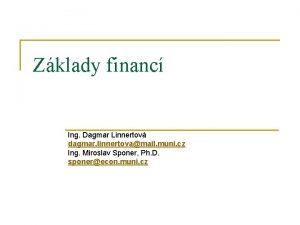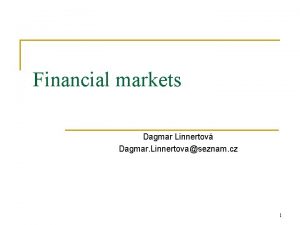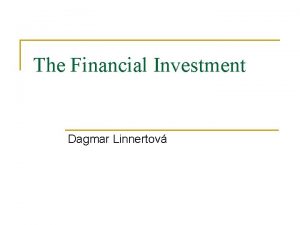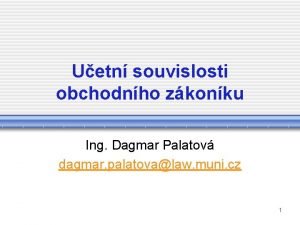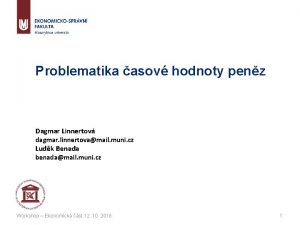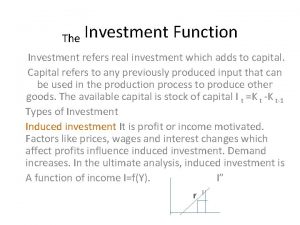Financial Investment Dagmar Linnertova Dagmar linnertovasmail muni cz
































































- Slides: 64

Financial Investment • Dagmar Linnertova – Dagmar. linnertova@smail. muni. cz – 2/2 – Seminars • Paper – form of bachelor thesis (approximately 10 pages) • Questions as a preparation for final test • Paper presentation • Final grade – Paper: 40 points – Final Test: 60 points

Financial Investment • Bodie Kane Marcus

Lecture 1 - The Investment Environment - Asset Classes and Financial Investments

Real Assets Versus Financial Assets • The material wealth of an economy is determined by production of the economy – How many goods and services are its members possible create • This can be produced by using real asset • In contrast to real assets are financial assets – Sheet of paper of computer entry – Means by which individuals hold claims on real assets • Auto plant vs. stock of Toyota

Real Assets Versus Financial Assets • Essential nature of investment – Reduced current consumption – Planned later consumption • Real Assets – Assets used to produce goods and services – Generate net income to the economy • Financial Assets – Claims on real assets – Allocation of net income along investors

• Distinction between real and financial assets – Table 1. 1 and 1. 2

Table 1. 2 Domestic Net Worth

Table 1. 1 Balance Sheet of U. S. Households, 2007

A Taxonomy of Financial Assets • Fixed income or debt – Fixed stream of income vs. Determined stream of income (some formula) • Corporate bonds or floating-rate notes – Money market instruments • Bank certificates of deposit – Capital market instruments • Bonds

A Taxonomy of Financial Assets cont. • Common stock or equity – Ownership in corporation – Without promise of regular payment • Derivative securities – Options, futures contracts – Underlying – Hedging – speculation

Financial Markets and the Economy • Information Role – Investor decides which company live of die – Bid up or bid down prices • Consumption Timing – Earning more or less than wish to spend – Store wealth in financial assets – Shift purchasing power

Financial Markets and the Economy cont. • Allocation of Risk – Real assets involve risk as well – Transformation risk according to investor profile – Bond vs stock • Separation of Ownership and Management – Companies owned and managed by same individuals – Agency Issues • Does management attempt to maximalise firm value? • Conflict of interest – Tie managers income to profit of a firm » Stock options » Analysis of pension funds or analysts » Treat of takeover – proxy contest or other firm

Financial Markets and the Economy cont. • Corporate Governance and Corporate Ethics – Financial market play important role in effective allocation of resources • Transparency of information – Accounting Scandals • World. Com • Examples – Enron, Rite Aid, Health. South – Auditors—watchdogs of the firms – Analyst Scandals • Arthur Andersen – Sarbanes-Oxley Act • Tighten the rules of corporate governance – 2002 – Independent directors that are not managers – Prohibit auditors providing another services

The Investment Process • Saving – Not spending all on consumption • Investing – Choosing what assets to hold • Safe, risky, combination • • Investors are making two decisions in creation of their portfolio Asset allocation – Choice among broad asset classes Security selection – Choice of which securities to hold within asset class Security analysis – Evaluation of assets • Top down portfolio – Asset allocation – Security selection • Bottom-up strategy – Securities that are attractively priced

Markets are Competitive • Prediction of future return – Risk associate with investment • Risk-Return Trade-Off – If all else is equal, investors will prefer investments with the highest expected return • Else can not be equal • Fair return to risk • Efficient Markets – Role of information – Active Management • Finding mispriced securities • Timing the market – Passive Management • No attempt to find undervalued securities • No attempt to time the market • Holding a highly diversified portfolio

The Players • Business Firms– net borrowers – Raise capital to pay for investments in plant and from income provides return to investors • Households – net savers – Purchase securities from firms that need capital • Governments – can be both borrowers and savers – After WWII mostly borrowers • Role of financial institutions and intermediaries

The Players cont. • Financial Intermediaries – Investment Companies – Banks – Insurance companies – Credit unions

Financial Intermediaries • For the households is direct investment difficult • For small investor is lending money related with transactional costs • Entrance of financial intermediaries – Bring them together – Different from another business • All their liabilities and claims are at most financial • Table 1. 3 compare with table 1. 4 • Primary function – Channelling funds from private to business sector • Pooling the resources from many small investors to be able to lend considerable sum of money • Lending to many borrowers – Diversification and thus can adopt risky project • Built expertise through volume of business they do – Economy of scale

The Players Continued • Investment companies – Pool and manage the money of many investors • Most household portfolios is not large enough to be spread among a wide variety of securities – Brokerage fees – Researcher costs • Mutual funds • Portfolios for individual investors • Investment Bankers – – Perform specialized services for businesses Markets in the primary market Expertise to security issuers Assisting in issuing securities

Table 1. 3 Balance Sheet of Commercial Banks, 2007

Table 1. 4 Balance Sheet of Nonfinancial U. S. Business, 2007

New Trends • • Globalization Securitization Financial engineering Information and computer networks

Recent Trends—Globalization • Investor is not limited only to domestic assets • Efficient communication technology and decreasing of regulatory borders • Possible way how to participate in foreign investments opportunities – Domestically traded securities that represent claim to share of foreign stocks – Purchase of foreign securities that are denominated in domestic currency – Buy mutual funds that invest internationally – Buy derivative securities with payoffs that depend on prices in foreign security market • A giant step toward globalization 1999 – 11 European countries adopted euro

Figure 1. 1 Globalization: A Debt Issue Denominated in Euros

Recent Trends—Securitization • Mortgage pass-through securities – 1970 – Aggregation of individual home mortgages into homogeneous pool – This pool works as backed for pass through security – Investors get share in principal ale payments related with backed securities – Securitization of mortgages means that mortgages can be traded as securities • Other pass-through arrangements – Car, student, home equity, credit card loans • Offers opportunities for investors and originators

Figure 1. 2 Asset-backed Securities Outstanding

Recent Trends—Financial Engineering • Use of mathematical models and computer-based trading technology to synthesize new financial products – Principal-protected equity-linked note • Security that guarantee a minimum fixed return plus an additional amount that depends on the performance of some index • Bundling and unbundling of cash flows • Combination more than one security into a composite security or breaking up and allocation the cash flows from one security to create several new securities • Securities tailored according to investor risk

Recent Trends—Computer Networks • Online trading – Direct contact between customers and brokerage firm – Cheaper trading – Lower commissions • Online information dissemination • Information is made cheaply and widely available to the public • Automated trade crossing – Direct trading among investors • Trading without benefit for intermediaries such security dealers

Major Classes of Financial Assets or Securities • • • Money market Bond market Equity Securities Indexes Derivative markets

The Money Market • A subsector of the fixed income market – Short-term debt securities – Highly marketable – Traded in large denominations – Out of reach of individual investors

The Money Market cont. • Treasury bills – Most market able – Simple for of borrowing • • Government want to borrow from public Investors buy with discount from face value Maturities 28, 91 or 182 days Individual can buy directly in auction or from government securities dealer • Highly liquid – Bid and asked price – Bank discount method

The Money Market cont. • Certificates of Deposits – – CD time deposit with bank Can not be withdraw on demand Issued in denominations greater than 100. 000 USD Are negotiable • Commercial Paper – Issued by well-know companies rather than using bank loans – Very often backed by a bank line of credit • Access to cash that can be used to pay off the paper at maturity – Issued in multiple of 100. 000 – For small investor open only indirectly

The Money Market cont. • Bankers Acceptances – Order to a bank by bank’s client to pay a sum of money at a future day, typically within 6 months – Can be traded in secondary market – It is selling with discount from face value

The Money Market Continued • Eurodollars – Dollar-denominated deposits at foreign bank

The Money Market Continued • Brokers’ Calls – Individual who buy securities on margin borrow part of the funds to pay for the stocks from their broker – Broker may borrow the funds from a bank, agreeing to repay immediately on call if the bank request it – Price about 1 % higher than the rate on short-term T-bills

The Money Market Continued • Repurchase Agreements (RPs) and Reverse RPs – It is used by dealers with government securities – Form of short term borrowing – Most deposits are in large sum, time deposit less then 6 months • Overnight – Dealer sells government securities on an overnight basis with the promise to buy back these securities next day – Dealer get 1 -day loan from the investor – Securities work as collateral – Safe in term of credit risk

LIBOR Market • London Interbank Offered Rate – Large banks in London are willing to lend money among themselves – Short-term interest rate quoted in European money market – Reference rate for a wide range of transactions

Figure 2. 1 Rates on Money Market Securities

Table 2. 1 Major Components of the Money Market

Figure 2. 3 The Spread between 3 -month CD and Treasury Bill Rates

The Bond Market • Longer term borrowing • Debt instrument that are not traded in money market • Mostly traded with fixed income capital market instruments – Either fixed stream of income – Stream of income that is determined from specific formula

The Bond Market • • • Treasury Notes and Bonds Inflation-Protected Treasury Bonds International Bonds Municipal Bonds Corporate Bonds Mortgages and Mortgage-Backed Securities

Treasury Notes and Bonds • Maturities – Used by government for debt financing – Notes – maturities up to 10 years – Bonds – maturities in excess of 10 years – 30 -year bond – Semiannual interest payments called coupon payment • Par Value - $1, 000 • Quotes – percentage of par

Inflation-Protected Treasury Bonds Called TIPS – The principal amount is adjusted in proportion to increase of CPI

International Bonds • Many firms borrow abroad and many investors buy bonds from foreign issuers • In additional to national capital markets, there is a rising international capital market, largely concentrated in London • A Eurobond – Bond denominated in a currency that is different from country where it is issued • Eurodollar bond – E. g. A dollar-denominated bond sold in UK • Many firms also issue bonds in different currency that is same as a currency of a investor – Yankee bond dollar denominated, sold in US by non-dollar issuer – Samurai bond yen denominated bond, sold in Japan by non-Japanese issuer

Municipal Bonds • Issued by state and local governments • Types – General obligation bonds • Backed by faith and credit of issuer – Revenue bonds • Issue to finance commercial project – Backed by revenues from this project – Airports, hospitals, etc. – Riskier than GOB • Industrial revenue bonds – Revenue bond to finance commercial enterprises • Maturities – range up to 30 years

Municipal Bond Yields • Interest income on municipal bonds is not subject to federal and sometimes not to state and local tax • To compare yields on taxable securities a Taxable Equivalent Yield is constructed

Corporate Bonds • Issued by private firms – Borrow money directly from public – In structure almost same as Treasury issues • Semi-annual coupon • Return the face value • But different degree of risk – default risk • Secured bonds – collateral backing them in the event of firm bankruptcy • Unsecured bonds - debentures – no collateral • Subordinate debentures – lower priority claim to firm’s assets • Options in corporate bonds – Callable – right of issuer to repurchase bond from the holder at a set price – Convertible - right of issuer to convert bond into a number of shares of stock

Mortgages and Mortgage-Backed Securities • Developed in the 1970 s to help liquidity of financial institutions – Mortgages written for long term 15 – 30 year maturity with fixed interest rate and fixed monthly payments – conventional mortgages • Difficulties from lenders if interest rate increase – Adjustable-rate mortgage • Mortgage-Backed Security – Proportional ownership of a pool or a specified obligation secured by a pool – Securitization in mortgage market – Called as a pass-throughs • Market has experienced very high rates of growth

Figure 2. 7 Mortgage-backed Securities Outstanding, 1979 -2007

Equity Securities • Represent ownership in a corporation • The corporation is controlled by a board of directors that are elected by shareholders • The boar that meet only a few time each year selects managers who actually run the corporation on a day-to day basis.

Equity Securities • Common stock – Residual claim • The last in line of all those who have a claim on the assets and income of the corporation • After tax authorities, employees, suppliers, bondholders and other creditors • If a firm is not in liquidation – After interest and taxes – Limited liability • Shareholders can lose only original investment

Figure 2. 8 Listing of Stocks Traded on the NYSE

Equity Securities • Preferred stock – Fixed dividends - limited • Same as infinite-maturity bonds • No voting rights – Cumulative preffered stock • Unpaid dividends are cumulated and must be paid in fully before any other dividends – Tax treatment • Are not tax-deductible expenses for the firm • Depository receipts - ADRs – Certificated that represent ownership in shares of a foreign company – Traded un U. S. markets

Stock Market Indexes • There are several broadly based indexes computed and published daily • There are several indexes of bond market performance • Others include: – Financial Times Index

Dow Jones Industrial Average • Includes 30 large blue-chip corporations • Computed since 1896 • Originally simple average of the stocks included in the index – Add up prices of the 30 stocks and it is divided by 30 – Percentage change in DJIA is percentage change in average price of the 30 shares – Holding of portfolio of 30 shares (one share of each stock in the index) • Value of portfolio is value of 30 shares • Price-weighted average

Example 2. 2 Price-Weighted Average Portfolio: Initial value $25 + $100 = $125 Final value $30 + $ 90 = $120 Percentage change in portfolio value = 5/125 = -. 04 = -4% Index: Initial index value (25+100)/2 = 62. 5 Final index value (30 + 90)/2 = 60 Percentage change in index -2. 5/62. 5 = -. 04 = -4%

Standard & Poor’s Indexes Improvements of DJIA in two ways - Broadly based index of 500 firms – Market-value-weighted index – Calculating the total market value of 500 firms and total market value of those firms in previous day – The change in the value represent the change in index – The rate of return of index represent the rate of return of portfolio of investor that hold 500 stocks in proportion to their market value • How to invest in index – Index funds – Exchange Traded Funds (ETFs)

Other U. S. Market-Value Indexes • NASDAQ Composite – Index of all NASDAQ listed stocks • Subindexes – industrial, utility, transportation and financial stocks – Mode broadly bases than S&P 500 • NYSE Composite • Wilshire 5000 – NYSE and Amex stocks plus actively traded NASDAQ stocks – About 6000 stocks

Figure 2. 9 Comparative Performance of Several Stock Indexes, 2001 -2006

Foreign and International Stock Market Indexes • Nikkei (Japan) • FTSE (Financial Times of London) – ”footsie” • DAX (Germany) • MSCI (Morgan Stanley Capital International) – International index • About 50 country indexes and some regional indexes • Hang Seng (Hong Kong) • TSX (Canada)

Derivatives Markets • One of the most significant developments in financial markets in recent years • Provide payoffs that depends on development of another assets such commodity prices, bonds, stocks, market indexes, etc. • Derivative assets or contingent claims – Value derive from or is contingent on the values of another assets

Derivatives Markets Options • Basic Positions – Call (Buy) – Put (Sell) • Terms – Exercise Price or strike price – Expiration Date – Assets Futures • Basic Positions – Long (Buy) – Short (Sell) • Terms – Delivery Date – Assets

Thank you for your attention
 Fixed investment and inventory investment
Fixed investment and inventory investment Saving investment and the financial system
Saving investment and the financial system Fundamentals of analyzing real estate investments
Fundamentals of analyzing real estate investments Saving, investment, and the financial system
Saving, investment, and the financial system Modern corporate finance
Modern corporate finance Gold financial global investment co., ltd.
Gold financial global investment co., ltd. Mankiw chapter 26 solutions
Mankiw chapter 26 solutions The investment function in financial services management
The investment function in financial services management Financial investment analysis
Financial investment analysis Dagmar hartung von doetinchem
Dagmar hartung von doetinchem Drip elements of marketing communications
Drip elements of marketing communications Dagmar model
Dagmar model Palvelun kerrokset
Palvelun kerrokset Dagmar narusson
Dagmar narusson Dagmar torilo
Dagmar torilo Dagmar steffens
Dagmar steffens Stormen dagmar
Stormen dagmar Tidvist
Tidvist Stadgenoot woningruil
Stadgenoot woningruil Dagmar mattiisen
Dagmar mattiisen Markalama sürecinin aşamaları
Markalama sürecinin aşamaları Dagmar jandová
Dagmar jandová Dagmar zahradnik
Dagmar zahradnik Dagmar olivier
Dagmar olivier Non-financial methods of motivation
Non-financial methods of motivation Aleph muni
Aleph muni Isu muni
Isu muni Muni cast
Muni cast Is.muni.cz
Is.muni.cz Muni econ
Muni econ Muni ezdroje
Muni ezdroje Statistica muni
Statistica muni Pert diagram
Pert diagram Kariera muni
Kariera muni Econ muni harmonogram
Econ muni harmonogram Eiz muni
Eiz muni Econ muni
Econ muni Brno university masaryk
Brno university masaryk Is muni přihlášení
Is muni přihlášení Law muni
Law muni Eiz muni
Eiz muni Studijní katalog fi muni
Studijní katalog fi muni Moodlinka
Moodlinka Supo muni
Supo muni Axasia
Axasia Inet muni
Inet muni Eiz muni
Eiz muni Anatomický ústav muni
Anatomický ústav muni Web of knowledge
Web of knowledge Is.muni.c
Is.muni.c Https://is.muni.cz
Https://is.muni.cz Is.muni.cz login
Is.muni.cz login Katedra psychologie ped muni
Katedra psychologie ped muni Muni psychologie
Muni psychologie Iskam muni
Iskam muni Fi muni dod
Fi muni dod Eduroam muni
Eduroam muni Citační směrnice prf muni
Citační směrnice prf muni Ebsco muni
Ebsco muni Kaa muni
Kaa muni Law muni
Law muni Is muni
Is muni Muni ezdroje
Muni ezdroje Investment practice
Investment practice Investment appraisal questions
Investment appraisal questions

